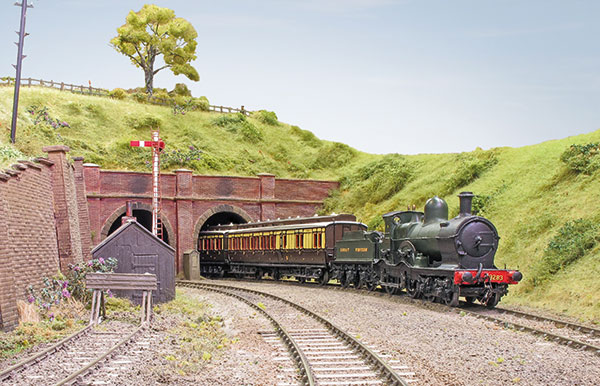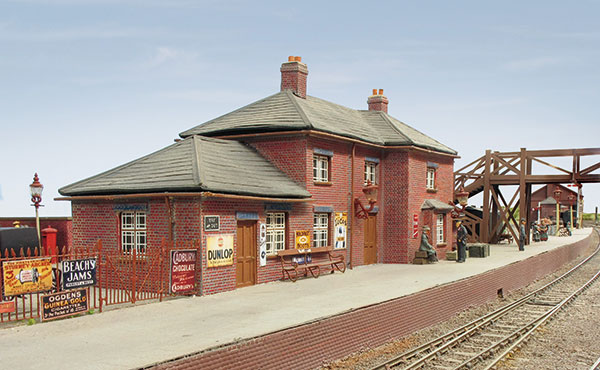28 May 2020
|
Fact and fiction merge in this layout that faithfully reimagines a junction on the Shrewsbury to Hereford line, recreating a real village that never had a station.
Factfile
Layout name: Hope-Under-Dinmore
Scale/gauge: EM
Era/region: 1900-1920 GWR/LNWR
Location: Shrewsbury to Hereford main line
Layout type: Exhibition
Power/control: DC
Words: Duncan Redford
Photography: Andy York
Hope-under-Dinmore is a real place, with a railway running by it, but it never had a station. However, acting on the premise that one should never let the truth get in the way of a good story, an intrepid band of EM gauge modellers have indulged their imagination and ‘sexed up’ the already interesting history of the Shrewsbury to Hereford line.
It is a pre-grouping layout, based on the GW & LNWR joint line, and EM gauge. And, as a relative newcomer to the South Hants Model Railway Club, I can honestly (and modestly) say that it’s been done very, very well – just not done by me. The chief modellers are Richard Butler (of Westcliff fame) and Dave Bridges, assisted by Tony Witts (who devises all sorts of electrical trickery), Roger Davies, Derek Harris and Dave Smith (of 'Brighton East' fame). Me? I just hang around and play trains from time to time.

Our Hope is a model of a small country junction on a relatively busy double track mainline. The branch line meanders off towards the Welsh borders. The architecture of the buildings is unique to the Shrewsbury to Hereford line, which meant most of the railway’s structures had to be scratchbuilt, principally using Slater's Plastikard.
The station building is a mirror image of Dinmore station, south of Dinmore tunnel. The signal boxes are based on the one at Leominster and the Goods Shed comes from Woofferton. The branch line trestle bridge is based on one north of Aberystwyth, on the Cambrian coast line. The warehouse by the river is based on a building in Nailsworth, Gloucestershire. The platform shelter was laser cut by one of the South Hants members, Jonathan Buckie, to a LNWR design.

The layout is conventional DC powered, although we can run DCC too. Occasionally, to give the old folk in the team something to complain about, we raise the subject of making the whole layout DCC and DCC sound.
The signals, which are of LNWR design, all work, as do the ground signals, and are built from MSE parts; the distant signals are red, rather than the yellow used from the mid 1920s onwards. Sometimes, if I’m having a really good day, I even manage to signal the trains correctly. Othertimes, Tony and Roger are kind enough to point out when I’ve done it wrong. Sometimes, I listen to them.

Rolling Stock
The stock is mostly supplied by Richard (GWR) and Dave (LNWR), with smaller contributions from myself and Dave Smith, as well as Ray Hodson and Derek. We use Alex Jackson couplings, which we find reliable, cheap and easy to make with the jigs that are now available commercially, especially if you have good stock boxes that make sure there is no sliding around of items whilst in transit or storage.
Locos that are being, or threatened to be, built by one or other of us include GWR Stella, Scott Atlantic, 43xx, 28xx, Armstrong Goods, Aberdare Goods and 1076 classes as well as LNWR Jubilee, E Class, Problem and Teutonic classes.
In addition, Richard has now dipped his toe into the waters of the LNWR, building a rake of Ratio LNWR corridor coaches. He has also suggested he might dig out some of his GWR 70ft stock after a research trip to the original records at the National Archives revealed that these coaches once ran on the line (as well as through-coaches from the Midland, West Coast Joint Stock and Caledonian).

I keep dropping hints that Richard, as a master of the Tri-ang Clerestory ‘cut and shut’ method of producing beautiful panelled coaches, should do a Caledonian brake tri-composite, but he continues to feign deafness. Dave Bridges, on the other hand, has found a part built Caledonian bogie saloon coach, which he is keen to finish, and Derek is producing some Cambrian coaches. I’m busy building four and six-wheeled siphons, laser-cut by a friend at London’s Model Railway Club, as well as stock for stone trains and a fitted express goods.
Indeed, we are now starting to suffer from an embarrassment of riches in the stock department and the fiddleyards are now pretty much at the limit with regards to what we can run – currently eight trains in the 'up' direction, nine in the 'down' direction and five in the branch fiddleyard (including steam railmotors, both GWR and LNWR). In the summer of 1907 (in real life) over 37 'up' or 'down' trains would have passed the point where we chose to site our imaginary station. We do try to run a fair representation of the sort of trains that ran on the line from express and local passengers, to fast freight and pick up goods.
As the stock availability goes up, we will continue to refine the operating schedule. In order to add operational interest we have extended the siding used by the branch freight behind the south signal box so that we can now pass wagons from the 'down' line and goods yard to the branch in addition to the current move between 'up' line and branch line.

Exhibiting
We are also keen to constantly improve how the layout is presented to the public. Stock is checked before all exhibitions and troublesome items removed as soon as possible for repair. We also try to ensure that something is moving on the layout at all times. Other care helps present the layout to best effect – it is meticulously dusted before exhibitions to get rid of those strange bits of small white ‘stuff’ that seem to appear out of nowhere and stand out violently against the greens and browns of the grass and ballast.
The back scene, curves to avoid sharp corners that catch the eye and made into one long piece to make sure there are no gaps in the sky, is a definite plus, even if it takes three or four of us to get it safely in position. By the time of our next outing, the layout should be enhanced by several information panels along its front.
And the future? Periodically, the idea of making more trees to go above the tunnel is mentioned, considered and then quietly forgotten. The scenery is given a quick spruce up. While Hope keeps getting invitations we will continue to do what we enjoy best and play trains.

